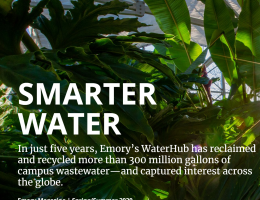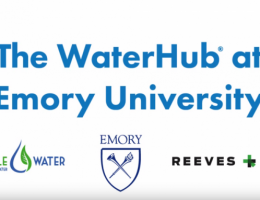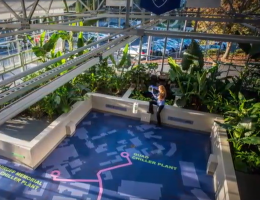WaterHub Highlights
- The WaterHub at Emory is a water recycling system that uses eco-engineering processes to clean waste water for future non-potable uses like flushing toilets.
- Installed in 2015, it is the first system of its kind in the United States.
- Emory’s WaterHub is capable of recycling up to 400,000 gallons of water each day–nearly 40 percent of Emory’s total campus water needs.
By 2025, we plan to reduce Emory water use by 50 percent, including eliminating drinking water use for heating, cooling, toilet-flushing and other non-potable uses. The WaterHub is a critical part of meeting this goal.
WaterHub Benefits
Emory is located in Atlanta which is the largest municipality reliant for drinking water on the smallest single watershed (Chattahoochee) in the country.
The system reduces the draw of water from Atlanta’s municipal water supply by up to 146 million gallons of water annually, which helps ensure the availability of water for all and saves the University millions of dollars in water utility costs.
The WaterHub includes a 50,000 gallon emergency water reserve, which will allow Emory’s heating and cooling systems to function for an average of seven hours in the event of any disruption in water availability.
How It Works
- Wastewater is extracted and cleaned with the help of organisms that utilize biomimicry to break down pollutants in the water.
- Reclaimed water is used in utilities, like to heat and cool buildings through the steam and chiller plants and residence halls or toilet flushing in some residence halls.
- The WaterHub was made possible by an innovative water purchase agreement between Emory University and Sustainable Water, a water reclamation technology provider.
- Two on-site solar panels offset about 30% of energy used by the facility.
40%
of Emory's total water use is reclaimed by the WaterHub at Emory
425
million+ gallons of water have been recycled by the Emory WaterHub since it opened in April 2015.
75%
of cooling tower make-up water in 2020 was reclaimed, instead of using potable water





